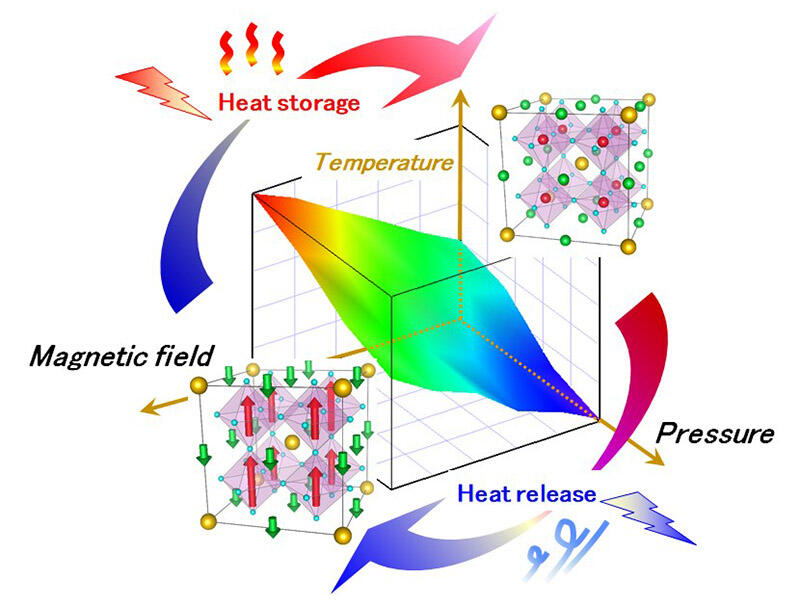In order to move heat in an out of an environment, an air conditioner compresses the air. Changes in the temperature state of an object as a result of changing the pressure, magnetic field, or electric field are known as the calorific effect, and it was widely believed that these effects are the result of a single field change in a substance.
Doctoral student Yoshihisa Kosugi, Assistant Professor Masato Goto, Dr. Zhenhong Tan, Associate Professor Daisuke Kan, and Professor Yuichi Shimakawa of the Kyoto University Institute for Chemical Research; and Kenji Yoshii, Principal Investigator of Japan Atomic Energy Agency, in collaboration with the Japan Synchrotron Radiation Research Institute, National Institute of Advanced Industrial Science and Technology, Max Planck Institute for Solid State Research, demonstrated that the ferrimagnet BiCu3Cr4O12, which has a perovskite structure showing charge transfer, exhibits a large calorific effect when a magnetic field and pressure are applied and is a new solid material in which highly efficient thermal control can be achieved. These results were published in Scientific Reports.
Currently, 25%-30% of the world's electricity consumption is used for cooling and heat control, and by extension understanding of the caloric effect, is a global issue. The calorific effect increases as the change in entropy increases. For example, more heat flows in and out during the phase transition between ice and water than between just ice or just water. Even if the material is solid, when accompanied by phase transition, it has a large calorific effect, which facilitates the development of a compact and efficient cooling system. Therefore, research and development is being conducted globally on the issue.
The collaborative research team focused on the perovskite-structured oxide, BiCu3Cr4O12, which exhibits ferrimagnetism (ferromagnetic magnetic properties) with multiple giant caloric effects, large latent heat and strong correlation in charge-spin-lattice degrees of freedom, as a candidate for a multi-calorific effect material that can control heat in multiple external fields. This material undergoes a first-order phase transition at 190 K with changes in charge (the valence state of chromium). At the same time as this transition, the magnetic moments of copper and chromium in BiCu3Cr4O12 are arranged so that it becomes ferrimagnetic, and at that time, the magnetic entropy changes significantly (28.2 J / K-kg). Therefore, near the phase transition temperature, a magnetic heat effect that can change this entropy occurs upon applying a magnetic field. In other words, the magnetic field enables heat storage and heat dissipation.
A magnetic field of 50 kOe can achieve an adiabatic temperature change of approximately 3.9 K. On the other hand, this material can also undergo phase transition upon applying pressure and also exhibits a pressure-based calorific effect that causes an adiabatic temperature change of approximately 4.8 K upon applying a pressure of 490 MPa. In short, it was demonstrated that heat can be controlled efficiently via multiple methods of applying magnetic field and pressure. On top of this, by applying the external magnetic and pressure fields cooperatively, thermal control can be performed efficiently under conditions that cannot be reached using only one external magnetic or pressure field. Another useful characteristic is that heat loss, which is a problem in practical use, may be offset by adding two external fields simultaneously.

Credit: Kyoto University
Professor Shimakawa said, "This substance may also have an electrocaloric effect, and so we are currently in the process of verification. We also believe that by using other transition metals instead of chromium and optimizing the structural design, even higher calorific effects can be achieved in various temperature ranges. We are currently conducting experiments to verify our hypothesis."
This article has been translated by JST with permission from The Science News Ltd.(https://sci-news.co.jp/). Unauthorized reproduction of the article and photographs is prohibited.




